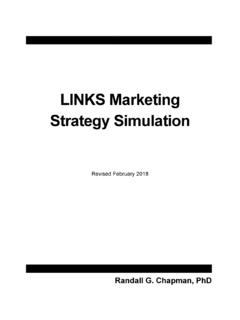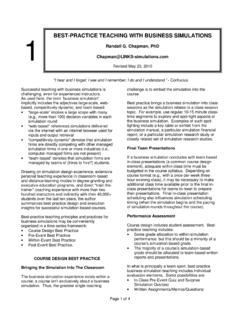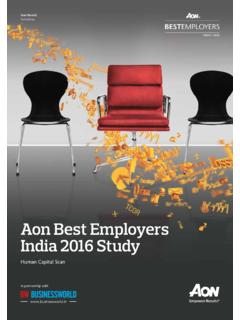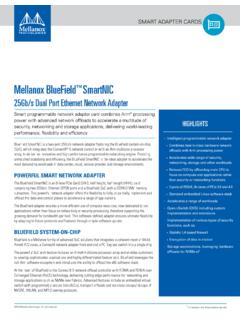Transcription of LINKS Supply Chain Management Simulation
1 LINKS Supply Chain Management Simulation Revised February 2018 Randall G. Chapman, PhD 2 LINKS Supply Chain Management Simulation Copyright (c) 2000-2018 by Randall G Chapman LINKS is a registered trademark of Randall G Chapman. All rights reserved. ISBN 1885837-37-2 LINKS Supply Chain Management Simulation 3 Table of Contents Chapter 1: Introduction .. 7 Overview ..7 Supply Chain Why Use Simulations? ..8 What Will You Learn? ..9 LINKS Overview ..9 What Will You Do Within LINKS ? ..12 Decisions and Decision Forms ..13 Excel Spreadsheet Access To This Manual s Exhibits ..14 Chapter 2: Decision Variables and Perspective .. 15 Overview ..15 Perspective and Definitions ..17 Currency Conventions in LINKS ..17 Chapter 3: Product Development Decisions .. 18 Overview ..18 Set-Top Box Configurations ..18 Product Costs.
2 19 Chapter 4: Procurement Decisions .. 21 Overview ..21 Raw Materials ..22 Sub-Assembly Components and Supplier Decisions ..23 Inventory Management For Postponed Production ..25 Replacement Parts ..26 Emergency Procurement ..26 Relationship Management Costs ..26 SAC Surface Shipping ..27 Procurement Decisions Form ..28 Chapter 5: Manufacturing Decisions .. 31 Overview ..31 Perspective on Manufacturing and Postponed Production ..32 Production and Postponed Emergency Production ..36 Production Volume Flexibility ..37 Unfilled Orders ..39 Manufacturing Decisions Form ..40 Chapter 6: Distribution Decisions .. 42 Overview ..42 Distribution Center Decisions ..43 4 LINKS Supply Chain Management Simulation RFID-Application For Retail-Channel Sales ..44 Emergency Shippers For Plant-To-DC Shipments ..45 Cross-Docking ..45 Surface Shipping Methods ..47 Distribution Decisions Form.
3 47 Chapter 7: Transportation Decisions .. 49 Overview ..49 Transportation Responsibilities ..50 Plant Shipments To Distribution Centers ..50 Distribution Center Shipments To Customers ..54 Outbound Shipments ..55 Emergency Transportation Shipments ..55 FGI Surface Shipping ..56 Transportation Decisions Form ..57 Chapter 8: Service Decisions .. 59 Chapter 9: Generate Demand Decisions .. 61 Overview ..61 Channel Decisions ..61 Price Decisions ..62 Marketing Spending Decisions ..64 Introduction/Drop Decisions ..66 Generate Demand Decisions Form ..66 Chapter 10: Forecasting Decisions .. 68 Overview ..68 A Judgmental Sales Forecasting Template ..69 Forecasting Accuracy ..69 About Forecasting and Forecasting Accuracy ..69 Forecasting Decisions Form ..69 Chapter 11: Information Technology Decisions .. 72 Overview ..72 IT Synchronization With Plant-To-DC Shippers ..72 IT Synchronization With Sub-Assembly Component Suppliers.
4 73 Procurement Transactions Report ..74 Product Cost Report ..75 Replacement Parts Demand Report ..75 Retail Pipeline Report ..75 Transportation Cost Report ..76 Transportation Report ..76 Information Technology Decisions Form ..76 Chapter 12: Other Decisions .. 78 LINKS Supply Chain Management Simulation 5 Chapter 13: Financial and Operating Reports .. 80 Overview ..80 Profitability Drivers ..80 Performance Evaluation Report ..84 Corporate P&L Statement ..84 Historical Corporate P&L Statement ..85 Product P&L Statement ..86 Balance Sheet ..86 Cash Flow Analysis Report ..86 Other Reports ..87 Sample Reports ..88 Chapter 14: Research Studies .. 100 Overview ..100 Research Studies Strategy ..101 Research Study #1: Benchmarking - Earnings ..104 Research Study #2: Benchmarking - Balance Sheets ..104 Research Study #4: Benchmarking - Procurement ..104 Research Study #5: Benchmarking - Manufacturing.
5 105 Research Study #6: Benchmarking - Distribution ..105 Research Study #7: Benchmarking - Transportation ..106 Research Study #9: Benchmarking - Generate Demand ..106 Research Study #10: Benchmarking - Info Tech & Research Studies ..107 Research Study #11: Benchmarking - Operating Statistics ..107 Research Study #12: Market Statistics ..108 Research Study #14: Regional Summary Analysis ..109 Research Study #20: Customer Satisfaction ..110 Research Study #24: Price Sensitivity Analysis ..110 Research Studies Decision Forms ..112 Chapter 15: Performance Evaluation .. 114 Overview ..114 The LINKS Scorecard ..115 Chapter 16: Firm Management and Advice .. 119 Overview ..119 Planning ..119 Team Management and Organization ..124 End-Gaming Strategies and Tactics ..125 General Advice ..125 Postscript ..125 Appendix: Web-Based LINKS Access .. 126 Index .. 128 6 LINKS Supply Chain Management Simulation LINKS Supply Chain Management Simulation 7 Chapter 1: Introduction Chapter 1 Overview LINKS Supply Chain Management Simulation firms manage procurement, manufacturing, distribution and warehousing, transportation, service, generate demand, forecasting, information technology, and research studies.
6 LINKS encompasses all Supply Chain elements: suppliers, manufacturers, distributors, retailers, and end-users. In LINKS , you manage the Supply Chain of an on-going high-tech manufacturing business. Working with your team, you re in direct competition with other firms in your LINKS industry. Your goal is to improve your firm's overall financial, operating, and market performance. The learning objectives implicit in LINKS include the following: Gaining exposure to all Supply Chain elements individually and to their associated interactions Appreciating the need for balance and managing trade-offs in Supply chains Experiencing competitive dynamics in an evolving marketplace Appreciating information flows and integration of information with decision making Enhancing and encouraging fact-based analysis and decision making Gaining familiarity with financial statements used routinely in for-profit businesses.
7 Traditional financial statements, operating reports, and optional research studies provide an information-rich environment for LINKS . Information Management is important within Supply Chain Management and LINKS includes various optional information enhancements (information technology and research studies) available for a fee. In LINKS , a multi-factor quantitative performance evaluation system is used. Financial, operating, and customer performance measures are combined to create an overall measure of performance in the style of a balanced scorecard. LINKS is a Supply Chain Management Simulation encompassing product development, procurement, manufacturing, distribution, transportation, service, generate demand, forecasting, and information technology, plus associated research study resource options. This chapter introduces LINKS , provides a perspective on Management Simulation learning, and overviews the analysis-planning-implementation-evaluat ion cycle that you'll experience.
8 8 LINKS Supply Chain Management Simulation Supply Chain Management Supply Chain Management addresses fundamental issues of controlling the planning, sourcing, making, and delivering of manufactured goods. The Supply Chain encompasses sourcing and procurement, production scheduling, order processing, inventory Management , transportation, warehousing, and customer service. Service is not an incidental part of Supply chains for manufactured goods; it is fundamental to the customer experience. The intangibles implicit in service must be combined with the traditional tangibles associated with manufactured goods to account for the whole customer experience that the Supply Chain tries to deliver. Supply chains also include information systems (IT) to monitor, control, and manage these activities.
9 Seamless sub-process coordination and integration is the hallmark of successfully managed Supply chains. Supply Chain Management includes consideration of partners: suppliers, carriers, and third-party providers. In LINKS , you have the opportunity to assume Management responsibility for the Supply Chain of an on-going high-tech manufacturing business. Working with your teammates, you are in direct competition with other firms in your LINKS industry. Your goal is to improve your firm's overall financial, operating, and market performance. Although you and your teammates have ultimate responsibility for your LINKS firm, a coach will be available to assist you throughout this exercise. Thus, you won't be alone, even at the beginning. Why Use Simulations? "I hear and I forget; I see and I remember; I do and I understand.
10 " Confucius Why use simulations in Management education? Why not use traditional classroom lectures, perhaps combined with case studies? Adults learn best by doing. "Doing" involves taking responsibility for one's actions, receiving feedback, and having an opportunity to improve through time. In Management education and training settings, Management simulations support learning in a non-threatening but competitive environment of the kind that real managers face every day. Like an airline pilot flight simulator, a Management simulator allows more rapid time compression, FYI: Supply Chain Management Definition Supply Chain Management coordinates suppliers, factories, warehouses, distribution centers, and retail outlets to produce and distribute items to the right customers, at the right time, and at the right price to minimize costs while satisfying a certain level of service.










